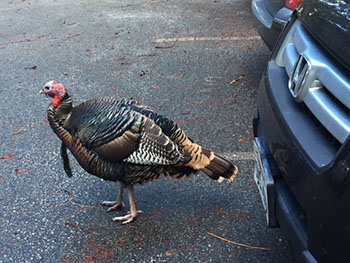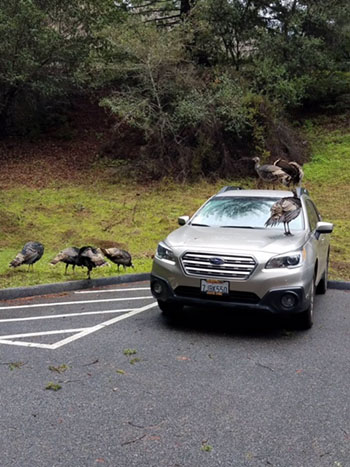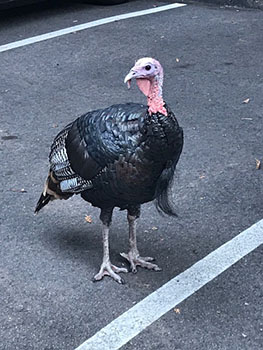It’s not your imagination. The turkeys have multiplied.
Noisy gaggles of wild turkeys have claimed UC Santa Cruz as their home turf. Now they are roosting in Douglas firs and redwoods, stampeding through fields, breeding with reckless abandon, and blocking roads with total indifference.
“Turkeys run the campus,” one student posted. Another student mentioned that he’d called his mother, who was visiting campus, and informed her that he couldn’t get out because a "turkey" was blocking his car. The confused mother, believing that her son was referring to a fellow student as a "turkey," scolded him for his rudeness. “No need to call people names!” she told him.
The turkeys cause plenty of hilarity and drama on campus, with students filming videos of elaborate mating rituals going on outside McHenry Library or posting updates on Instagram about noisy encounters with the prehistoric-looking creatures.
But for all of their entertainment value at UC Santa Cruz, these birds are also the subject of some pressing questions from staff and faculty members wondering about their impacts to biodiversity on campus. Is their population getting out of control, and what is their impact on local wildlife?
“I had a half serious conversation with a few others about radio-collaring some of the turkeys to get a better picture of where they're going and perhaps what they're eating,” said Chris Lay, curator of UC Santa Cruz’s Kenneth Norris Center for Natural History. “It's likely they're significantly impacting some populations of small- to medium-sized critters on the campus.”
They also have a taste for agriculture. Sky DeMuro, an apprenticeship instructor for UC Santa Cruz’s Center for Agroecology and Sustainable Food Systems, reports that turkeys are “a problem in the Alan Chadwick Garden—cute, but eating crops and disturbing beds with their dust baths.”
Big birds, bigger attitudes
Until someone takes a closer look at the wild turkey population, the impact is only a matter of speculation. It is hard to know if these super-birds are driving out or negatively impacting other creatures, or merely filling an empty niche, like pigeons crowding the ledges of a New York City skyscraper.
But one thing is for sure: Students, and other members of the UC Santa Cruz community, have been having more interactions with the birds. “It seems to me that they are more prevalent in the past three years,” noted Alex Jones, UC Santa Cruz Campus Natural Reserve manager.
And these big birds have attitude to spare. “I’m scared to cross the street; they’re vicious!” said Caroline Alfonso (Porter ’21, art), only half-jokingly, while looking at seven turkeys strutting through the parking lot beneath the campus’s Theater Arts Center.
Like many students, Alfonso has a combination of affection and wariness when it comes to the turkeys. On the one hand, she respects them. “They just don’t care. It is honestly admirable. Look at their faces. They’re kind of goblin-like—wrinkled, covered in warts, but they own it. They rock their looks, and they rock the campus.”
On the other hand, “they are so aggressive. I used to feel bad about eating turkeys. Now I feel less sympathy. I saw a bigger one attack a small one. There was a lot of neck action.”
These strutting, preening birds don’t have anything close to the cult status of banana slugs on campus. But certain birds—most notably the irreverently named Hank Hatebeak, a huge turkey with his own Facebook fan page—have become part of the UC Santa Cruz landscape. So many stories are circulating about Hank that certain staff and faculty members now wonder if the “Hank” we know is actually a composite of different turkeys.
“I had a run-in with Hank,” said Bruce Lyon, a professor of physical and biological sciences. “He basically stopped traffic and was pecking tires. I guess he was a bit pumped up with testosterone. I couldn’t really drive anywhere for a few minutes.”
Lyon has an intriguing theory about Hank’s seeming hatred of cars, stemming from his travels to British Columbia, where he has studied grouse, a relative of the turkey.
One day, Lyon was sitting inside a Toyota 4Runner, close to a place where the birds congregated for courtship displays during their mating season. “Every time we revved the car, the grouse stamped their feet,” Lyon recalled. “It got them really excited. Then it occurred to me that the car was mimicking the vibrational noises the grouse were making. Perhaps there is something about the noise (of a car) that makes Hank think it is a competitor, trying to lure females.”
Then again, there might be other reasons for Hank’s surly interactions with automobiles. “It is such weird behavior that we have to grasp at straws: why is he doing that?” Lyon said. “Another possibility is he sees his reflection in the hubcaps. Birds are famous for pecking car mirrors because they don’t see themselves, they see a rival. Maybe the tiny little head of theirs just doesn’t have that much brain material, and they’re kind of dumb.”
A statewide situation
If you find yourself befuddled and intimidated by the campus’s turkeys, remember that these creatures are not limited to UC Santa Cruz. You will also find them pecking, mating, and brawling their way through nearby Wilder Ranch State Park. In fact, these turkeys can be found in forests, golf courses, farms, and meadows across the state.
Long ago, the state had a population of native turkeys, who left behind fossil evidence in the La Brea Tar Pits of Southern California, but they went extinct between 10,000 and 12,000 years ago.
The turkeys that have taken over much of the Golden State are transplants from other areas of the United States, as well as Mexico. From the 1900s to the 1950s, thousands of farm-raised turkeys were set free here as part of a California state government-sponsored recreational hunting program, but this did not lead to any noticeable population explosion.
Then the state undertook another round of turkey introduction from 1959 through the 1990s, importing and releasing thousands of tough and wily wild turkeys from Texas, which fared much better than their domesticated predecessors.
These days, the state has an estimated 250,000 turkeys making their home in a quarter of the land in California.
Local impacts
The great success of these turkey transplants has been a boon to license-holding turkey hunters, who are allowed to shoot two birds apiece during turkey season, which runs from November 11 to December 10.
These sports hunters are allowed to shoot these birds at any part of the state where they have legal access, including private ranchlands, “but definitely not college campuses or golf courses,” said James Herrera, a program technician with the California Department of Fish and Wildlife.
But while the National Wild Turkey Federation, a conservation and hunting advocacy organization, believes that “the comeback of the wild turkey is perhaps the greatest conservation success story in North America’s wildlife history,” that success story has caused concerns from environmental organizations. Two groups, the California Native Plant Society and Save Our Ranchlands and Forests, jointly filed a lawsuit in the 1990s, seeking to block further introductions of turkeys and other non-native species.
Alex Jones, the natural reserve manager, wonders if the turkeys are eating more than their share of acorns, or if they are having other biotic impacts. But those questions only lead to other questions. “I’m just wondering how we are going to figure out if they are an issue or a problem,” he said. “And how do we manage them if the population turns out to be too big?”
Turkeys are omnivores. Insects are a major source of protein for the baby turkeys, known as “poults.” Jones has seen turkeys scratching around piles of decomposing leaves, making him wonder if they sometimes devour the salamanders that can be found in those piles.
“As you know, UC Santa Cruz is a weird wonderland for wildlife,” Jones continued. “The abundant deer and raccoons and other animals are losing their fear of humans. Turkeys seem like they are part of that group now.”
But in spite of their clueless boldness and their plentiful numbers on campus, these turkeys don’t seem to be a major food source for mountain lions lurking in the area. “We have literally not found any sign of pumas killing turkeys,” remarked Chris Wilmers, associate professor of environmental studies at UC Santa Cruz, and leader of the Santa Cruz Puma Project, which has been tracking mountain lions in the area.
Considering Hank Hatebeak’s tire-attacking gusto and generous proportions, one does have to wonder if researchers should be looking for evidence of turkeys attacking pumas.
How to observe a turkey
Since these turkeys don’t seem to be leaving this campus anytime soon, or ever, students, staff, and faculty should heed the advice of Todd Newberry, emeritus professor of biology at UC Santa Cruz, and a widely respected birdwatcher—and learn how to observe these birds in action.
“You can learn firsthand about turkeys just by 'watching and wondering,' no theories about why’s, just observations,” advised Newberry, author of The Ardent Birdwatcher, a series of illustrated essays about the pleasures of birdwatching. “Take lots of field notes but restrict them to jottings of just four wordless sorts: sketches of appearances, bird counts, maps of where the birds are ecologically, and simple diagrams of their behavior.
“Be sure to include what you hear,” he continued. “Soon enough you will recognize a few of your birds individually. What a moment of insight! What a reward for your patience! And you will begin to learn some of their language—what clucks and squawks seem to go with what situations. For sure, do not just glance and go; look and listen and linger. Notice.”
Watching turkeys in action, observers might also turn their thoughts to Benjamin Franklin, who held these birds in higher esteem than our national symbol, the eagle, Newberry said.
While Franklin called the eagle a “rank coward,” and “by no means a proper emblem,’’ he admired turkeys for their bold and brash behavior—the same qualities that UC Santa Cruz students now recognize in Hank Hatebeak. “He is, though a little vain and silly, a Bird of Courage,” Franklin wrote.





